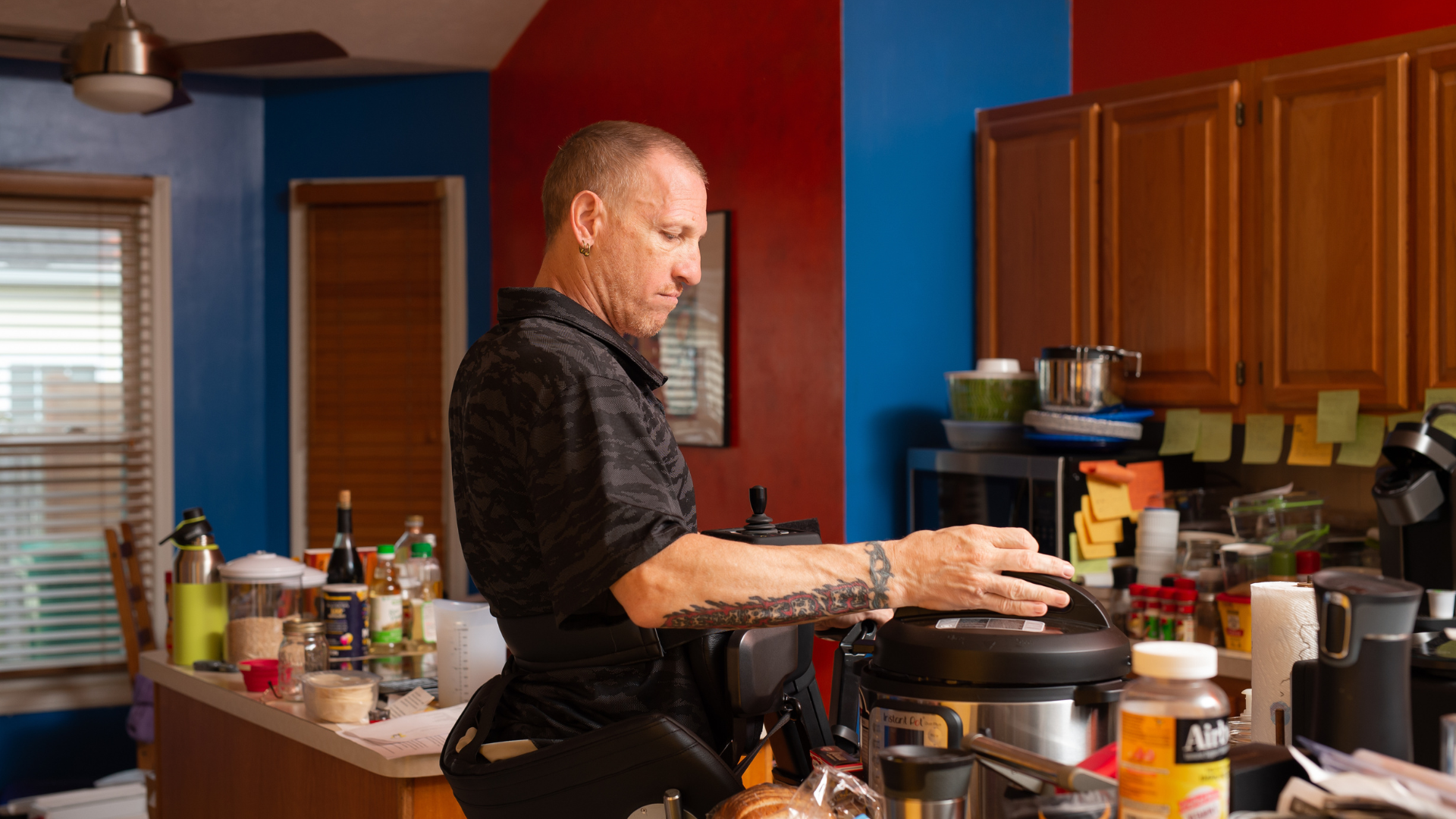Standing has numerous proven benefits. Being vertical is necessary to contribute to health and wellness, as many individuals with disabilities are at risk for secondary conditions due to immobility.
Switching positions throughout the day provides relief and comfort for those who spend the majority of their day sitting. For individuals unable to stand spontaneously, alternative means of supportive standing are necessary for individuals to benefit from an upright position. Some of these benefits of standing include:
- Improving ability to perform activities of daily living (ADLs): Standing can allow for greater vertical and forward movements to assist with improved functional reach. This can allow for greater access to and completion of ADLs such as dressing, grooming, cooking, toileting, and reaching for medications.
- Promoting pelvic alignment: For many wheelchair users, pelvic instability has a negative impact on posture, limiting function and contributing to musculoskeletal deformities and pain. Standing can promote pelvic alignment and strengthen the muscles in the trunk and pelvic girdle, helping to correct postural deformities.
- Pressure relief: Standing is an option for regular pressure relief, offloading the ischial tuberosities and sacrum and reducing the risk of pressure injuries.
- Respiratory support: Standing decreases pressure on internal organs including the lungs. This improvement of lung function leads to increased oxygenation of blood, promoting activity tolerance and muscle function.
- Assisting in the prevention of lower extremity contractures through stretching: Contractures decrease range of motion and shorten muscle length, negatively impacting function. Standing promotes active mobilization, which reduces contractures allowing for increased functional movement of joints.
- Decreasing the effects of lower extremity spasticity: Standing can reduce spasticity in the lower extremities by maintaining a supported, elongated position. Reducing spasticity has many benefits to wheelchair users such as safer transfers, increased functional completion of daily activities, and improved positioning in wheelchair.
- Circulatory training: Standing reduces pooling of blood in the lower extremities by increasing circulation throughout the body. Standing also decreases edema, deep vein thrombosis, and venous insufficiency.
- Stimulation of the autonomic nervous system: Standing can decrease risk for orthostatic hypotension and can improve cardiovascular functioning.
- Sensory input/proprioception: Weight bearing through the joints can promote sensory activation and gives proprioceptive input, helping individuals understand where his or her body is in space.
- Weight bearing: Weight bearing on lower extremities through standing can prevent contractures, reduce the risk of fractures and improve strength in bones and muscles.
- Bowel and bladder function: Standing can reduce the risk for constipation and improve bowel function. Standing helps to facilitate bladder emptying which can decrease risk for urinary tract infections (UTI) or other bladder related conditions.
- Psychosocial benefits: Standing promotes greater interaction with others and the environment and can lead to greater independence and social participation to enhance overall quality of life.
Advances in assistive technology make it possible for many wheelchair users to experience the benefits of standing (see following chart). This can be accomplished through wheelchair standing devices or standing frames, which provide postural stability and weight bearing opportunities for those who are unable to stand independently. A standing feature can be integrated into a manual or power wheelchair base to allow for transition from horizontal to vertical positioning. However, lack of funding can be a challenge to obtaining such devices. Clear and individualized justification of the client’s standing needs while referencing supportive evidence, can lead to more devices being funded over time. In the current environment, the clinical team including the certified Assistive Technology Professional (ATP) can explain and trial the latest technology available and associated funding requirements.

Thorough evaluation is required to ensure selection of appropriate standing devices that will maximize the benefits to the client. The benefits of standing are clear as they contribute to the overall health and wellbeing of the individuals we work with.
References
Arva, J., Paleg, G., Lange, M., Lieberman, J., Schmeler, M., Dicianno, B., & Rosen, L. (2009). RESNA position on the application of wheelchair standing devices. Assistive Technology, 21(3), 161-168.
Baker, K., Cassidy, E., & Rone-Adams, S. (2007). Therapeutic standing for people with multiple sclerosis. International Journal of Therapy and Rehabilitation, 14(3), 104-109.
Eng, J. J., Levins, S. M., Townson, A. F., Mah-Jones, D., Bremner, J., & Huston, G. (2001). Use of prolonged standing for individuals with spinal cord injuries. Physical therapy, 81(8), 1392-1399.
Glickman, L. B., Geigle, P. R., & Paleg, G. S. (2010). A systematic review of supported standing programs. Journal of pediatric rehabilitation medicine, 3(3), 197-213.
Harkema, S. J., Ferreira, C. K., van den Brand, R. J., & Krassioukov,
A. V. (2008). Improvements in orthostatic instability with stand locomotor training in individuals with spinal cord injury. Journal of neurotrauma, 25(12), 1467-1475.
Knecht, S., Hesse, S., & Oster, P. (2011). Rehabilitation after stroke. Deutsches Ärzteblatt International, 108(36), 600.
Paleg, G. S., Smith, B. A., & Glickman, L. B. (2013). Systematic review and evidence-based clinical recommendations for dosing of pediatric supported standing programs. Pediatr Phys Ther, 25(3), 232-247.
Permobil. (n.d.). The medical benefits of standing. Momentum Healthcare. Retrieved from http://www.permobil.com/en/ Corporate/



